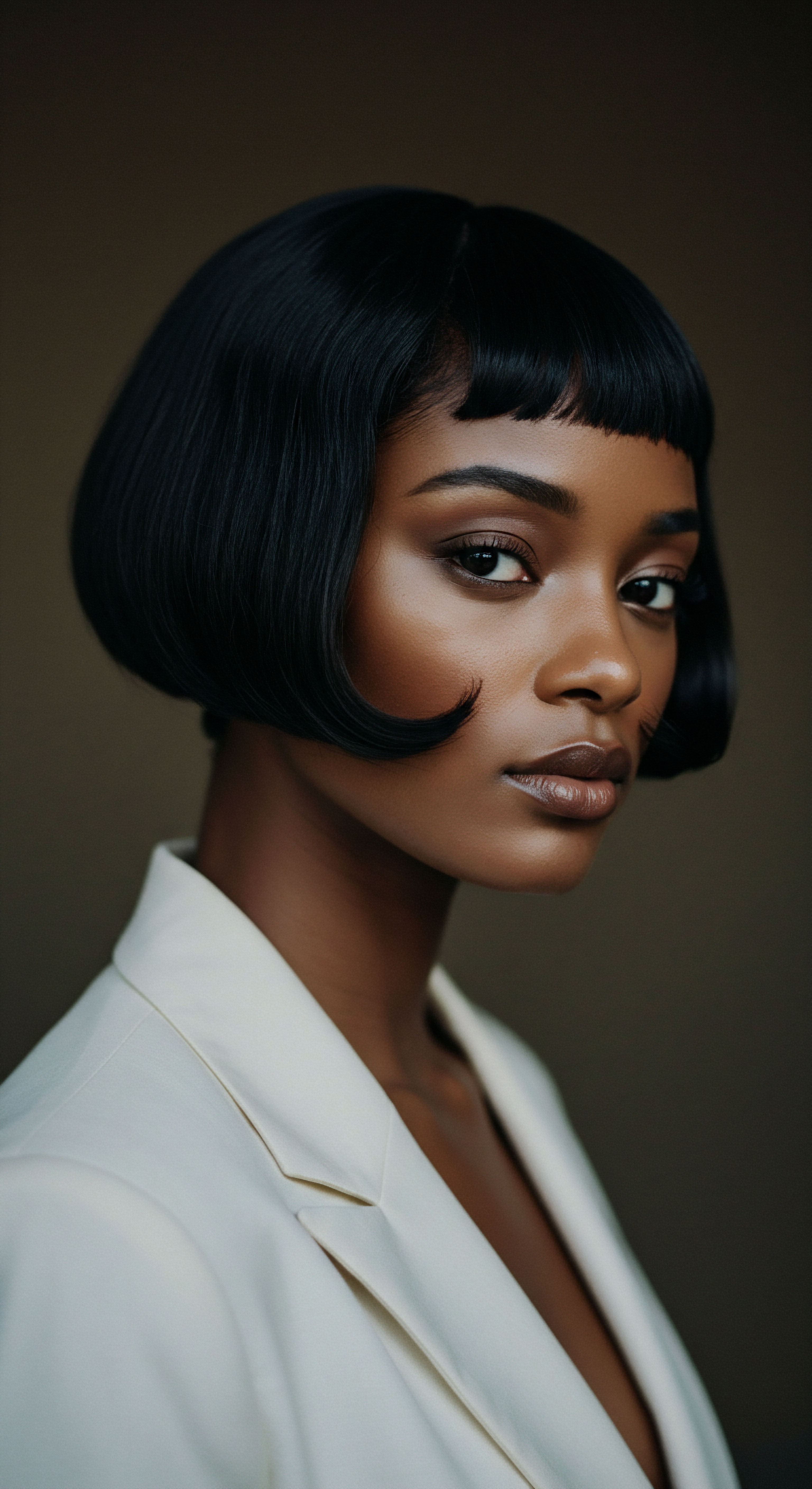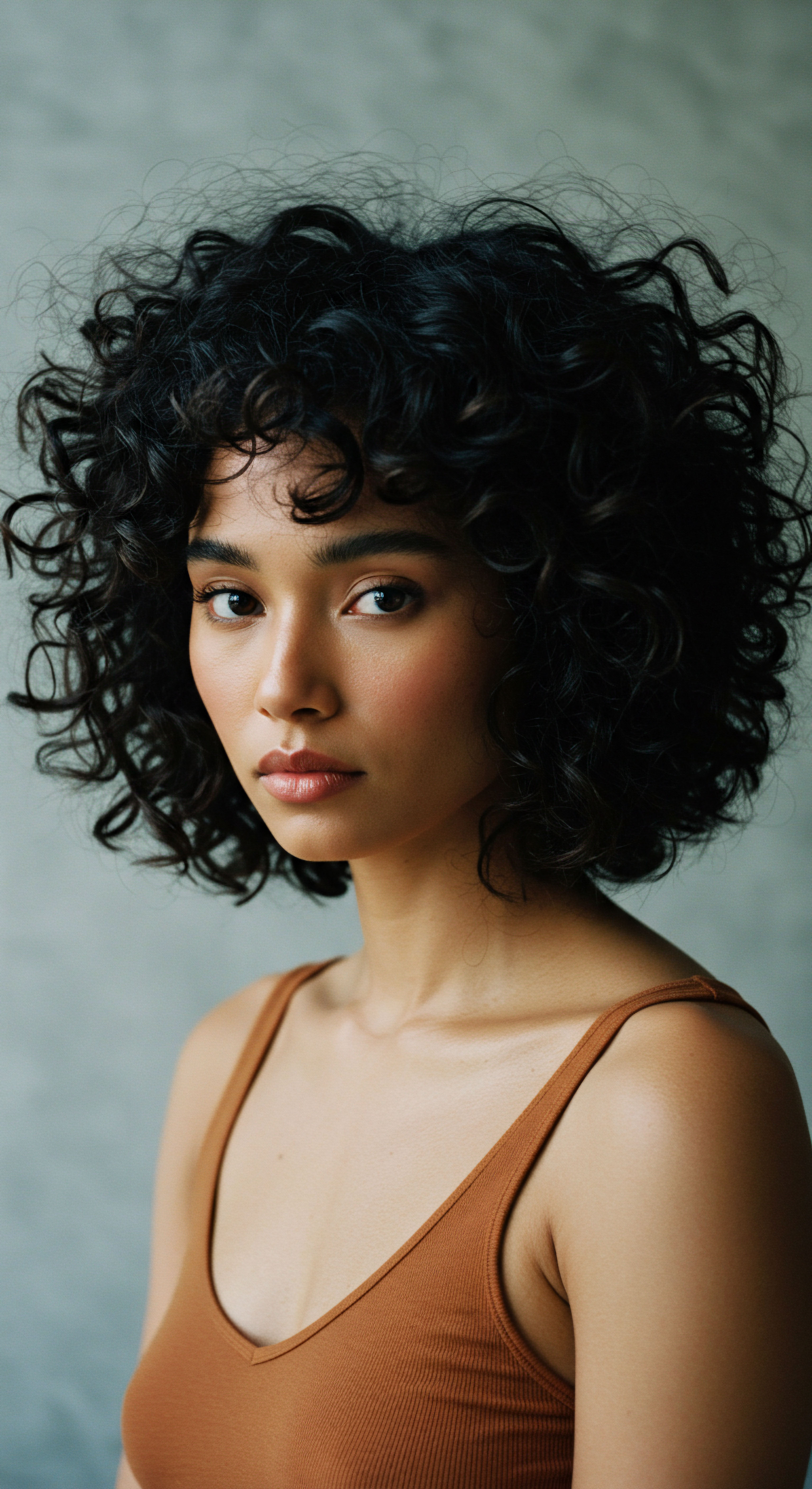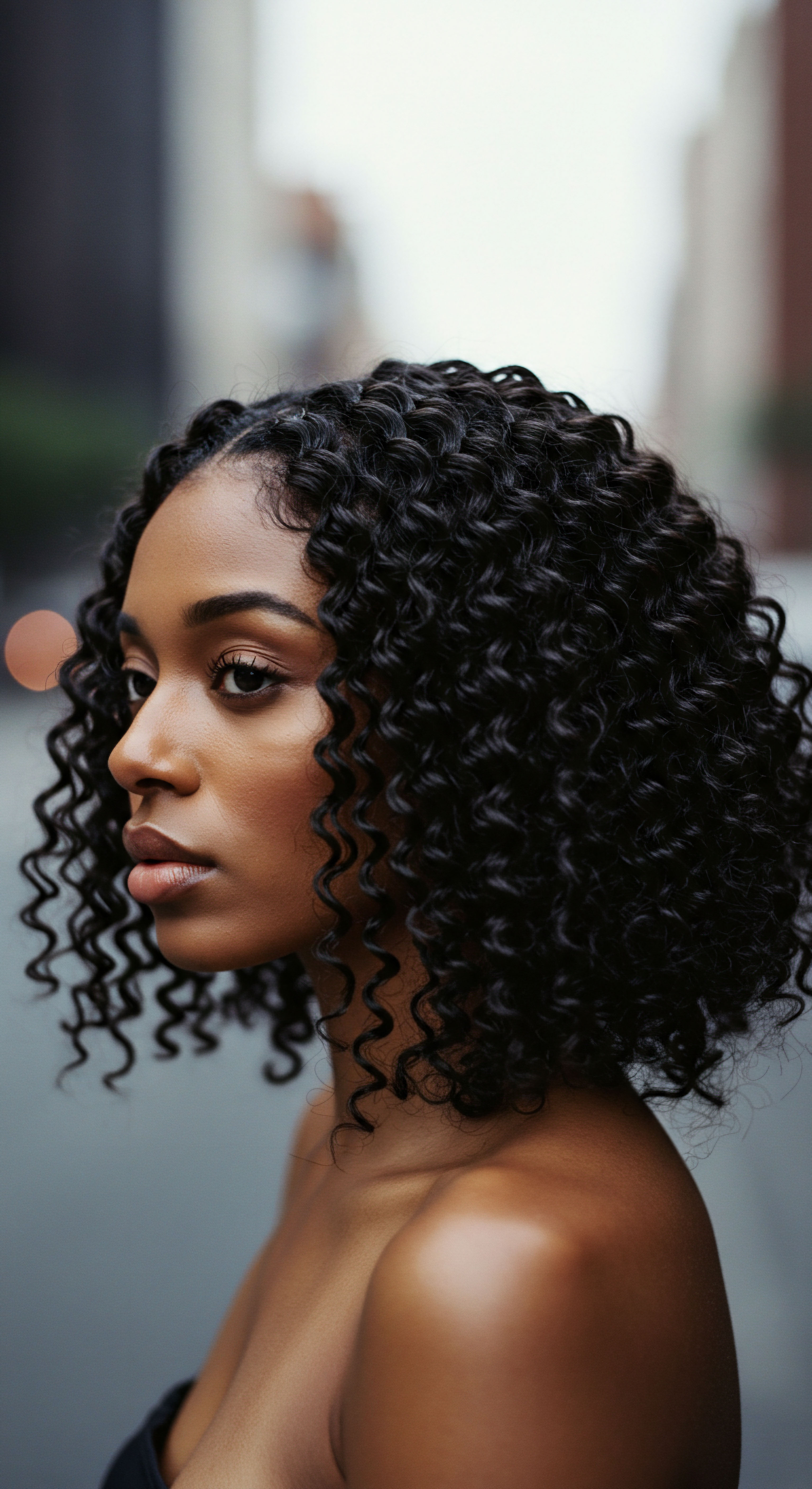
Roots
The quiet observation of human adornment, spanning countless centuries, reveals a persistent truth ❉ what we choose to place upon our bodies, especially upon our heads, often speaks volumes beyond mere aesthetics. Consider the ancient Egyptians, a civilization celebrated for its enduring artistry and profound symbolism. Their elaborate wigs, far from simple hairpieces, served as eloquent pronouncements of standing, cleanliness, and connection to the divine.
These intricate constructions, meticulously fashioned, offer a compelling lens through which to view a society where every visible detail carried a precise message. We step now into this ancient world, where the very fibers of a wig could articulate a person’s place within the grand order of the Nile.

What Did Ancient Egyptian Wigs Symbolize Beyond Appearance?
The Egyptians held a deep reverence for order and purity, concepts that extended to their personal presentation. Hair, in its natural state, could be difficult to manage in the arid climate and presented challenges for hygiene. Wigs offered a practical solution, allowing for easy removal for cleaning and protection from the harsh sun. Yet, their purpose transcended utility.
A wig’s material, its volume, its style, and its adornments all conveyed specific social cues. The choice of wig could communicate a person’s gender, their age, their occupation, and even their religious affiliation.
The materials themselves often spoke to privilege. While simpler wigs might consist of plant fibers or wool, the most esteemed were crafted from human hair. This human hair was often sourced from various means, including barbers collecting shorn locks or even from individuals who sold their hair. The sheer volume of hair required for some of the more voluminous styles suggests a considerable investment of resources, not just in raw material but also in the skilled labor necessary for construction.
Ancient Egyptian wigs functioned as sophisticated visual codes, communicating social standing, cleanliness, and spiritual connections.
The crafting of these hairpieces was an art in itself. Artisans would prepare the hair, often braiding it onto a mesh cap or a base of plant fibers, then setting it with beeswax or resin. The result was a structured, often weighty, piece that maintained its form and could be re-styled. The dedication of time and skill to produce such an item was a testament to the wearer’s ability to command resources and skilled labor, a clear indicator of their societal standing.

How Did Wig Materials Show Status?
The selection of materials for ancient Egyptian wigs was a direct reflection of a person’s position within the social hierarchy. Different types of wigs utilized distinct components, each carrying its own implicit message about the wearer’s access to wealth and specialized production.
- Human Hair ❉ Wigs fashioned from human hair were universally recognized as the most luxurious and therefore reserved for the elite. The acquisition of large quantities of human hair was itself a mark of prosperity, suggesting networks of supply and the ability to compensate those who provided it. Such wigs possessed a natural luster and movement that artificial fibers could not replicate, adding to their perceived value.
- Plant Fibers ❉ More common were wigs made from plant fibers, such as palm leaf fibers or linen. These were more accessible and likely worn by a broader segment of the population, including skilled laborers and lower-ranking officials. While less costly, their creation still required careful preparation and styling, demonstrating a level of care for appearance even among those of more modest means.
- Animal Hair ❉ In some instances, animal hair, particularly wool, found its way into wig construction. This could be for specific textures, for adding volume, or as a more readily available alternative to human hair for certain classes. The use of animal hair, though less prestigious than human hair, still represented an effort to conform to prevailing beauty standards.
The treatment of these materials also varied with status. High-ranking individuals would have their wigs adorned with precious metals, jewels, or scented cones made of solidified perfumed fat, which would slowly melt throughout the day, releasing a pleasant aroma. These additions further solidified the wig’s role as a marker of wealth and refined taste. The meticulous care and elaborate embellishment of a wig spoke of a life free from manual labor, a life where attention to personal grooming could be a daily pursuit.

Ritual
Shifting from the foundational elements, we consider now the practices that brought these elaborate hairpieces into daily and ceremonial existence. The act of wearing, maintaining, and presenting an ancient Egyptian wig was not a casual affair; it was a series of precise rituals, each step contributing to the projection of power and status. The donning of a wig was a deliberate act, akin to a ceremonial vesting, transforming the individual into a more idealized, powerful representation of themselves. This section explores the daily customs and broader societal practices that solidified the wig’s central role in conveying authority.

How Did Daily Wig Practices Show Standing?
For the ancient Egyptian elite, the wig was an indispensable part of their daily attire, a constant visual reinforcement of their position. The sheer size and weight of some wigs meant they were not simply placed upon the head; they were carefully positioned and secured, often with ribbons or pins. This required assistance, implying the presence of servants or attendants, another subtle yet powerful sign of wealth and authority. The act of having one’s wig adjusted or styled by another spoke volumes about one’s access to labor and leisure.
The upkeep of these elaborate pieces was equally demanding. Wigs required regular cleaning, re-oiling, and re-styling to maintain their pristine appearance. This routine would have been managed by specialized servants, freeing the wearer from such mundane tasks. The appearance of a perfectly maintained wig, always neat and lustrous, signaled a life of ease and constant attention to personal presentation, contrasting sharply with the unkempt appearance of those engaged in manual labor.
The daily rituals surrounding wig wear, from assistance in donning to meticulous upkeep, visibly underscored an individual’s high societal standing.
Moreover, the wig offered a degree of protection from the environment. In the intense Egyptian sun, a thick wig could shield the scalp, while in the often dusty conditions, it kept natural hair clean. This practical benefit, combined with the aesthetic and symbolic functions, made the wig a highly functional garment for the privileged. The ability to wear such a protective yet decorative item daily was a luxury.

What Role Did Wigs Play in Funerary Rites?
The significance of wigs extended beyond earthly life into the realm of the afterlife. In ancient Egyptian belief, maintaining one’s idealized form was essential for a successful transition to the next world. Wigs, being integral to this idealized image, were often included in funerary assemblages.
Mummified individuals were sometimes found wearing wigs, or wigs were placed within their tombs, ready for use in the eternal journey. This practice underscores the profound connection between personal appearance, status, and spiritual well-being.
The inclusion of wigs in burial sites also provides archaeologists with invaluable insights into their construction and usage. Examination of wigs recovered from tombs has revealed much about the materials and techniques employed. For instance, some wigs, despite their outward splendor, show evidence of common challenges. A study on ancient Egyptian mummified remains and associated hair artifacts has revealed instances of head lice and nits present even on wigs, indicating that even among the elite, parasitic infestations were a reality that necessitated constant vigilance and specific hygiene practices.
This surprising detail highlights a practical aspect often overlooked when considering these symbols of perfection; maintaining such elaborate coiffures, even for the privileged, involved ongoing effort against natural challenges. This reality suggests a more nuanced understanding of “cleanliness” as an aspiration, requiring consistent action, rather than a constant, effortless state.
| Aspect of Life Daily Wear |
| Wig Function Protection from sun and dust; cleanliness; formal appearance. |
| Social Implication Indicated leisure, access to servants for care, attention to personal display. |
| Aspect of Life Ceremonial Occasions |
| Wig Function Adherence to ritualistic dress; enhanced grandeur; visual uniformity. |
| Social Implication Signified participation in religious or state events, group identity for priests/officials. |
| Aspect of Life Funerary Practices |
| Wig Function Preparation for the afterlife; maintenance of idealized appearance. |
| Social Implication Assured status and identity in the eternal realm, continuity of earthly privilege. |
| Aspect of Life Wigs were central to projecting status and adherence to societal and spiritual norms. |
The elaborate care for wigs, both in life and for the afterlife, speaks to a deeply ingrained cultural value placed on presentation. It was not merely about looking good; it was about presenting the correct, powerful, and pure image to both society and the gods.

Relay
Moving into a more sophisticated examination, we consider how the very presence of these ancient Egyptian wigs relayed complex messages about authority, gender, and societal structure. The wig acted as a visual shorthand, instantly communicating a person’s standing without the need for verbal introduction. It was a silent, yet undeniably potent, declaration of power, deeply woven into the fabric of their social and political landscape. This section delves into the deeper cultural and economic underpinnings that gave the wig its profound meaning.

How Did Wigs Delineate Gender and Role?
Wigs in ancient Egypt were worn by both men and women, yet their styles often differed, subtly marking gender roles and specific societal functions. Men’s wigs, particularly those of high-ranking officials and pharaohs, tended to be shorter, more geometric, and often featured a tripartite arrangement, with two sections framing the face and one falling down the back. This conveyed a sense of order, control, and a disciplined authority. The Nemes headdress, while not a wig, was a symbolic representation of a pharaoh’s wig, further solidifying the connection between formal hair styling and royal power.
Women’s wigs, conversely, were often longer, more voluminous, and styled with cascading curls or braids. These styles, while still reflecting status through their craftsmanship, also conveyed ideals of beauty, fertility, and grace. The sheer quantity of hair in some female wigs would have been substantial, demanding significant resources and skilled styling. This distinction in style reinforced societal expectations for male and female presentation within the hierarchical structure.
Beyond gender, specific wig styles could also signify a person’s occupation or religious role. Priests, for instance, might wear simpler, often shaved or closely cropped wigs, signifying their purity and dedication to service. Soldiers might wear practical, less elaborate wigs for protection. The visual language of wigs was thus incredibly rich, allowing for immediate recognition of an individual’s place within the societal matrix.

What Economic Factors Sustained Wig Production?
The widespread use of wigs, especially among the elite, points to a significant economic infrastructure dedicated to their production. This was not a cottage industry but a specialized craft, requiring skilled artisans, a supply chain for materials, and a system for distribution and maintenance. The investment in such an industry further underscores the importance of wigs as symbols of power.
Consider the resources required:
- Raw Material Acquisition ❉ For human hair wigs, this involved a system for collecting hair, potentially from barbershops or through direct trade. For plant fiber wigs, it meant cultivation and processing of specific plants. This required organized labor and access to agricultural resources.
- Skilled Labor ❉ Wig makers were highly specialized artisans. Their craft involved intricate braiding, knotting, and styling techniques, often passed down through generations. These individuals would have been supported by the elite, reflecting their economic power.
- Adornments and Fixatives ❉ The resins, beeswax, oils, and perfumes used to set and scent wigs, as well as the precious metals and jewels for embellishment, represented further economic expenditure. The trade routes for acquiring rare resins or semi-precious stones were often controlled by the state, linking wig adornment directly to royal power.
The very existence of a thriving wig industry, supported by a clientele able to afford its products and services, serves as a clear indicator of the economic stratification within ancient Egyptian society. Those who wore the most elaborate wigs were not only displaying their personal wealth but also participating in an economic system that upheld their position. The wig, then, was not just a symbol; it was a tangible manifestation of economic might and the societal structures that sustained it.

Reflection
The journey through ancient Egyptian wigs reveals more than mere fashion; it uncovers a deeply ingrained language of visual communication, where each strand, each style, spoke of authority, purity, and connection to the world beyond. These hairpieces stand as a testament to humanity’s enduring impulse to adorn, to define, and to declare through personal presentation, reminding us that beauty, in its most profound sense, often carries the weight of history and the whispers of power.

References
- Rühli, F. J. et al. “Hair analysis in ancient Egypt ❉ a preliminary study of wigs from the New Kingdom.” Journal of Archaeological Science, vol. 37, no. 6, 2010, pp. 1297-1305.
- Robins, Gay. The Art of Ancient Egypt. Harvard University Press, 1997.
- Stevens, Anna. The Egyptian Book of the Dead ❉ A Guide to the Journey Through the Afterlife. Thames & Hudson, 2010.
- David, Rosalie. Handbook to Life in Ancient Egypt. Facts On File, 1998.
- Tyldesley, Joyce. Egypt ❉ The Nile and Its People. University of California Press, 2011.